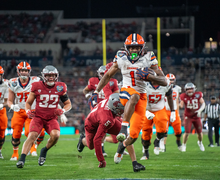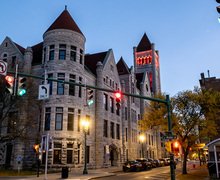School of Architecture students create Twister-like game for Syracuse bus stops
Chase Guttman | Asst. Photo Editor
Cuse-ster is modeled after Twister, but instead of solid dots, the spots on the Cuse-ster board feature silhouettes of important buildings in proximity to the bus stop where the game is being played.
A group of graduate students in Syracuse University’s School of Architecture put a Syracuse twist on the classic game Twister on Tuesday, launching a game of Cuse-ster at four bus stops in Syracuse.
Cuse-ster is modeled after Twister, but instead of solid dots, the spots on the Cuse-ster board feature silhouettes of important buildings in proximity to the bus stop where the game is being played, said Sophie Fraser Hafter, a member of the Cuse-ster group and a graduate student in the School of Architecture.
“What we wanted to do is, we were focusing on connecting the Syracuse University students with the city, and so we wanted to find a fun way to make people interact,” said Toni Jones, another member of the Cuse-ster group and a graduate student in the School of Architecture.
Cuse-ster, which was developed by the group of four students for their “Politics of Public Space” class, was deployed at bus stops on College Place, near Goldstein Student Center, the downtown Perseverance Square and near the Nancy Cantor Warehouse, Jones said.
The game launched at 10 a.m. on Tuesday and will be available at four bus stops on campus and in downtown Syracuse until around 10 a.m. on Wednesday.
Cuse-ster features two boards, — one on the ground and one hung on the wall of the bus stop — a spinner and a poster with instructions and a map of the game’s other locations. The game is played like Twister, but the player on the ground board must be able to read the fun fact — which is on the wall board — that corresponds to the newly spun spot.
As architecture students, the group was able to develop the boards using the dimensions from the original Twister mat. The students got silhouettes of the buildings and put them in a grayscale to make them stand out against the colors of the spots on the board.
Jones said there was not much use of the game when it was launched in the morning since people were “just waking up,” but said many were reading the facts on the board.
Through the “Politics of Public Space” class, taught by Lori Brown, a professor of architecture at SU, Fraser Hafter said the students learn what role architecture plays in public space.
Fraser Hafter, who is from London, added that public space is not used in the U.S. in the same way it is used in Europe, and taking away public space in Europe would cause “a lot of kickbacks” that might not happen in the U.S.
Public space is important, Fraser Hafter said, because it represents free speech and a place where people can voice their opinions.
“It’s very closely related to politics,” she said. “Having public space is somewhere where people can congregate and question things.”
Jones and Fraser Hafter added that public space is changing with the presence of the Internet. While the Internet is more focused on a younger generation, Fraser Hafter said that physical public space “encapsulates everyone in the community.”
Published on December 8, 2015 at 10:06 pm
Contact Alexa: atorrens@syr.edu





